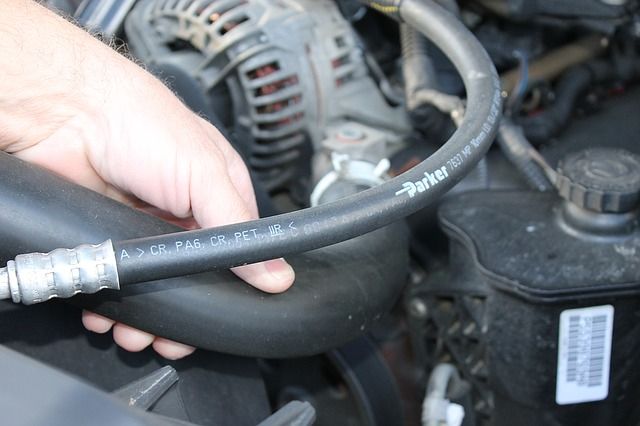Top 5 Reasons Why Your Coolant's Hose is Leaking (Updated)

A coolant's hose is something that doesn't stand out in any way. In fact, you probably don't think about it at all. You just assume it's there doing its job, and if it doesn't, then you realize how something insignificant as a simple hose can be so important after all.
The reason why coolant hoses are so important is that they prevent your car's engine from overheating. Your car's engine can literally be a furnace, and the process of burning gasoline in an internal combustion engine can reach 20,000 British Thermal Unit (BTUs) per gallon--enough to heat a 1,000 square feet room in a heartbeat.
What are Coolant Hoses?
 @pixabay.com
@pixabay.comCoolant hoses are just that: hoses. They are located at the upper and lower radiators, bypass, and heaters. Made from durable, synthetic rubber, they (at least the high-quality ones) can withstand pressure, vibration, chemicals, and heat, allowing the liquid coolant to flow freely between the engine and radiator, among others.
Causes of Coolant Hose Leaks
Unfortunately, even the best hoses will eventually wear out over time. Hose leaks are the most common result of this, and they occur when cracks or abrasions form on the hose. Over time, the cracks get bigger, causing it to leak coolant.
Here are the following reasons why these leaks occur in the first place:
Cause #1: Kinks
A kinked hose doesn’t necessarily indicate damage, but it does reduce the flow of your coolant, resulting to engine overheating. Besides, long-term kinks, when subjected to constant pressure, sharp edges or surfaces, can weaken prematurely, eventually creating small cracks that gets bigger and bigger over time.
What It Looks Like
These are common wave-like folds found on different areas of the hose.
How to Solve It
Oftentimes, kinks occur due to poor quality hoses. The best thing to do is to invest on the better ones on the market.
Cause #2: Not enough clamp torque / Damaged hose or connectors
These two causes are far easier to see. A hose or connector that’s damaged can be seen by the naked eye, and so is a loose clamp torque.
What it Looks like
Often, the number one indicator would be coolant bleed marks and drips found around the hose clamps and connectors. Also look for moisture and drips around the hose itself.
How to Solve It
Just tighten the tension clamps. Similarly, you can also opt for constant-tension clamps that automatically tightens (or loosens) depending on how hot or cold the system is.
Cause #3: Electrochemical Degredation (ECD)
Electrochemical degradation (ECD) occurs when different kinds of metals in the cooling system create an electric charge. The coolant transfers this charge to different areas, creating electric charges that cause cracks to form inside the hose.
What it Looks Like
ECD often starts within two inches of the hose’s end—near the connectors. Just squeeze the ends of the hose, and check if there are some spaces inside. Another indication might be softer ends on the hose compared to the middle part.
How to Solve It
The easiest way is to replace the hose. However, the best thing you can do is to buy hoses that are ECD-resistant. This is the best way to prevent the problem from happening.
You can also try using beaded connectors to enhance sealing. Cast iron and brass fittings actually meld well with rubber compounds after some time, which lessens the likelihood of hose leaks. If there are already small cracks, you can use sealants that come in viscous gels to plug in those cracks.
Cause #4: Engine heat / Insufficient coolant levels
Engine heat is a common problem of most drivers. One of the main reasons why this happens can be due to insufficient coolant levels.
What It Looks Like
Heat can cause a slight swelling in the hose, hardening it and causing cracks to appear on the surface.
How to Solve It
Choose better quality hoses that can withstand deterioration due to heat
Cause #5: Ozone Problems
Ozone concentrations actually increase as pollution rises. When this happens, the rubber compounds are affected, and small cracks provide enough opening for particles to come in and damage the hose.
What It Looks Like
Often, the cracks look like small, parallel cracks in the cover, especially at the hose bends.
How to Solve It
Choose high-quality hoses that are ozone-resistant.
Cause #6: Engine Abrasions
Abrasions commonly occur when a car’s engine components rub against one another.
What It Looks Like
Oftentimes, you can see the hose cover has damages, or there are rubbing marks on the cover.
How to Solve It
The best way here is to just replace the hose and make sure not to place it near sharp (or even blunt) surfaces. If you can’t avoid it, then you can rearrange the hose’s location so it will not come into contact with those objects. You can also cover the new hose with a protective sleeve at the point of contact, or simply reroute the hose by twisting it on the spouts.
Updated on August 28, 2020 by Gail Alcabaza
Also Read:
3 Common Car AC Problems Avoided with Regular Vehicle Maintenance
Featured Articles
- Latest
- Popular
Recommended Articles For You
Featured Cars
- Latest
- Upcoming
- Popular
Car Articles From Zigwheels
- News
- Article Feature
- Advisory Stories
- Road Test

